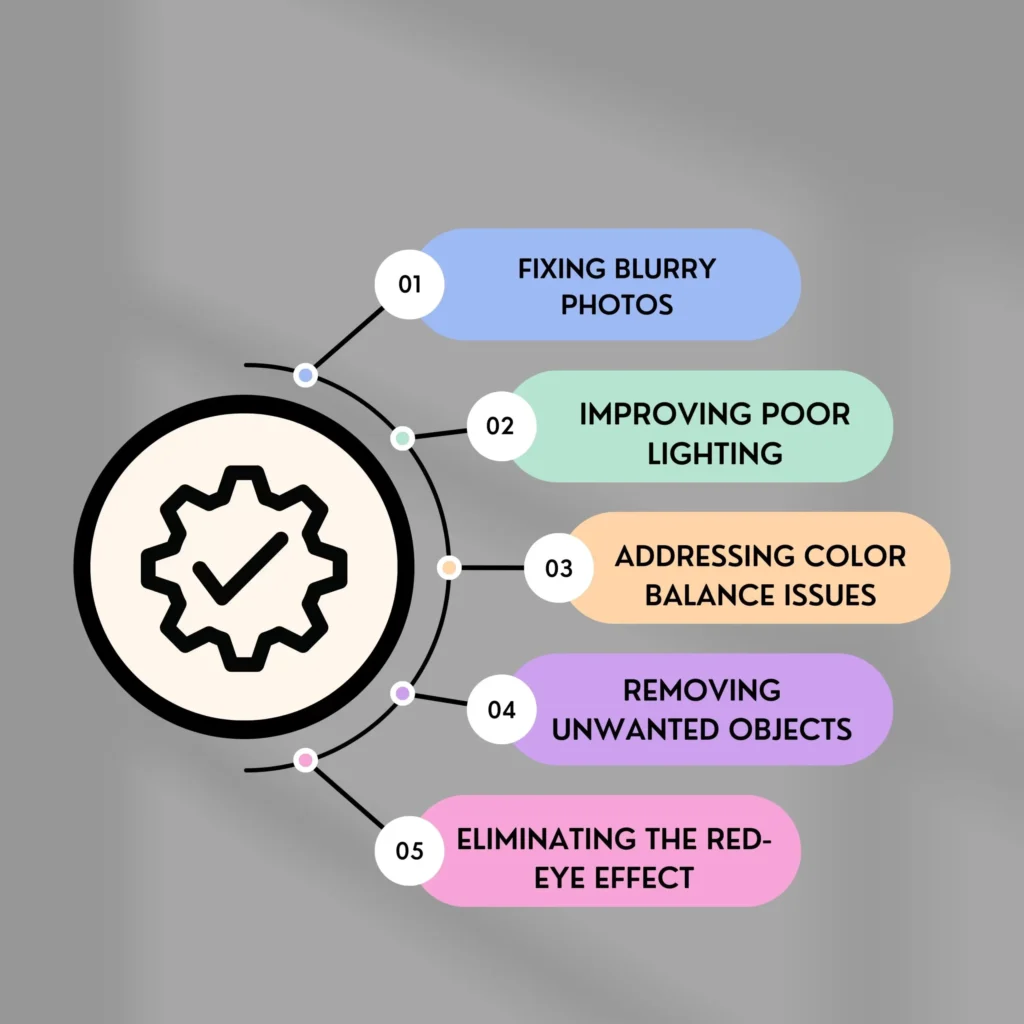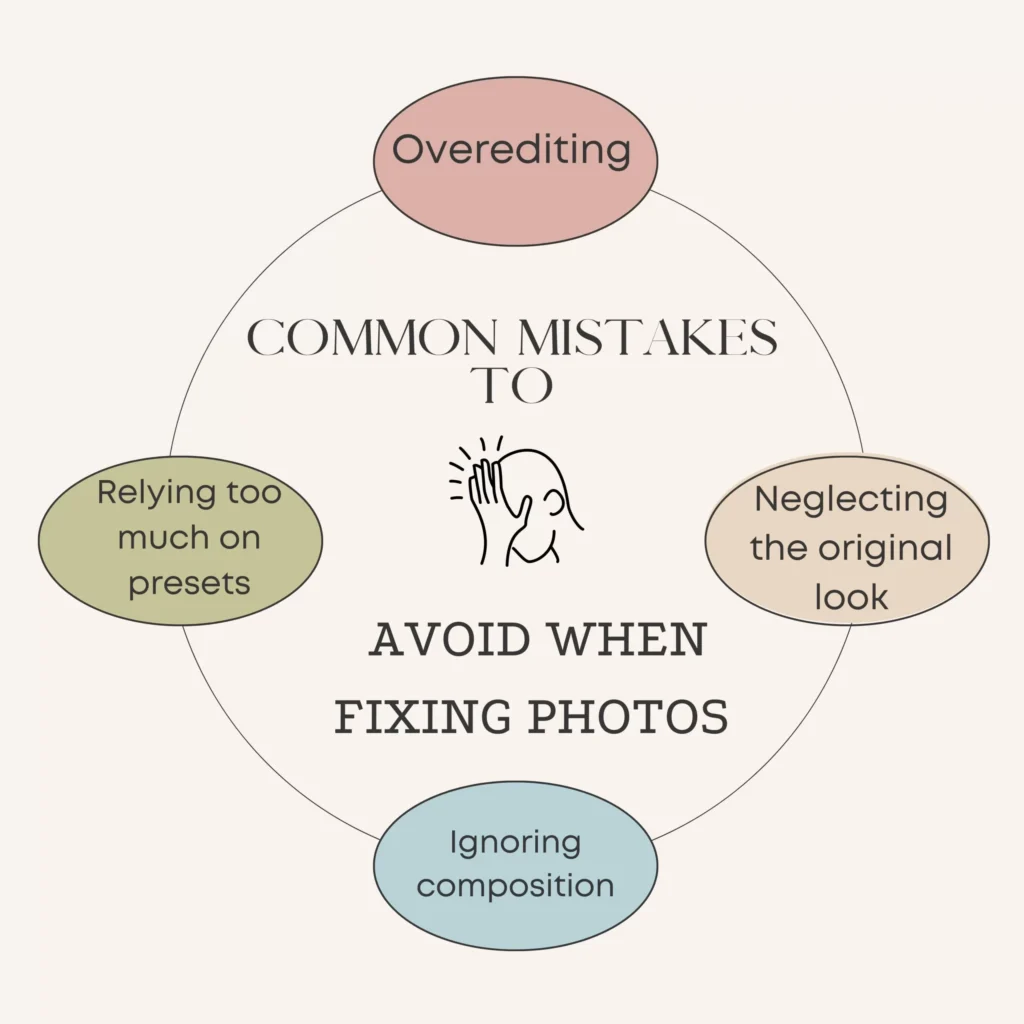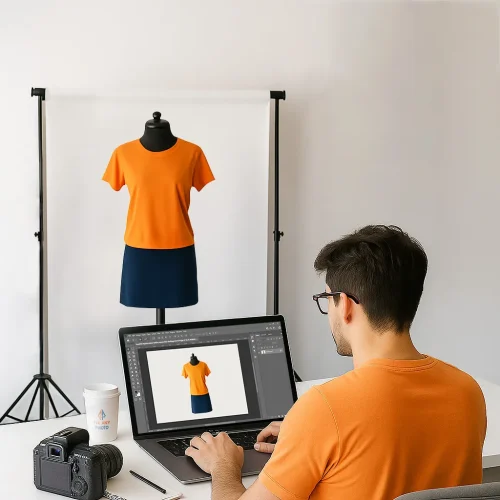These days, it’s easy to capture memories that are priceless thanks to digital technology. Still, there are times when the photos we take fall short of capturing the entire beauty of the scene. Fear not!
Great news – you don’t have to be a professional photographer to tackle these issues! In this guide, we’ll discuss a number of techniques and tools that answer the common question, “How can I fix a photo?” Let’s make your snapshots shine, no fancy camera skills are required!
Usual Photography Issues That We Fece
Before diving into the solutions, it’s essential to identify common issues that can affect your photos:

Blurry Images: Blurriness can result from shaky hands or a moving subject.
Poor Lighting: Low light conditions can lead to dark and grainy photos, while harsh lighting can cause overexposure.
Color Balance Issues: Sometimes, the colors in a photo may appear too warm, cool, or washed out.
Unwanted Objects: Whether it’s a distracting element, unwanted objects can detract from the main subject.
Red-Eye Effect: This common issue occurs when using a flash, causing the subjects’ eyes to appear red.
How to Fix The issues
You can elevate your photos from ordinary to extraordinary.
1. Fixing a Blurry photos:
Fixing a Blurry photo often result from camera shake or a moving subject. To fix this issue:
-
Use Image Stabilization: If your camera or smartphone has image stabilization features, make sure they are activated. This helps reduce the impact of shaky hands.
-
Editing Software: Utilize editing software with features like sharpening. This can enhance the clarity of your image. Adobe Photoshop and Lightroom are excellent choices.
2. Improving Poor Lighting:
-
Adjust Exposure: Most photo editing tools allow you to adjust exposure. Increase exposure for dark photos and decrease it for overly bright ones.
-
Use Filters: Filters can be a quick fix for color correction and improving overall image quality. Experiment with warmth and saturation adjustments.
-
HDR Mode: High Dynamic Range (HDR) mode on your camera or smartphone captures a range of light levels, enhancing details in both shadows and highlights.

3. Addressing Color Balance Issues:
White Balance Adjustment: Correct color imbalances by adjusting the white balance settings. This can be done both in-camera and during post-processing.
In your editing software, locate the color adjustment tools, which are usually found in the “Color” or “HSL” (hue, saturation, and luminance) section. Here, you can fine-tune the colors to achieve the desired effect.
Color Correction Tools: Photo editing software provides tools specifically designed for color correction. Experiment with sliders for temperature, tint, and saturation until you achieve the desired balance.
4. Removing Unwanted Objects:
Crop and Rotate: Sometimes, a simple crop or rotation can eliminate distracting elements. Most editing tools offer easy-to-use cropping features.
Clone Stamp Tool: Advanced editing software like Photoshop includes a Clone Stamp tool that allows you to ‘paint’ over unwanted objects, replacing them with nearby pixels.
5. Eliminating the Red-Eye Effect:
Red-Eye Reduction: Many cameras and smartphones have a red-eye reduction feature. If not, you can use editing software to manually correct red eyes.
Adjust Flash Settings: If possible, adjust your camera’s flash settings. Using an external flash or bouncing the flash off a surface can also help minimize red-eye.
Common mistakes to avoid when fixing photos

- Overediting: It’s easy to get carried away with editing, but be cautious not to overdo it. The goal is to enhance, not completely transform the photo.
- Neglecting the original look: While editing, it’s important to remember the original intention of the photo. Don’t lose sight of the emotions and story you want to convey.
- Ignoring composition: Even the best edits won’t salvage a poorly composed photo. Pay attention to composition rules and ensure your photo is visually balanced.
- Relying too much on presets: Presets can be a great starting point, but don’t rely solely on them. Take the time to fine-tune the settings to achieve the desired effect.
Additional Tips for Photographic Mastery

1. Preserve Originals:
- Before embarking on your editing adventure, ensure you keep a copy of the original photo. This serves as a safety net if things go awry.
2. Filters for Flair:
- Don’t shy away from experimenting with filters. They can add a creative touch and infuse your photos with unique personality.
3. Get to Know Your Tools:
- Invest time in understanding the features of your chosen editing software. This knowledge empowers you to make precise adjustments and unleash your creativity.
4. The Power of Practice:
- Photo editing is an evolving skill. Don’t be afraid to make mistakes. With each edit, you refine your skills and uncover new possibilities.
Why is it important to fix your photos?
Preserving Authentic Moments:
Real photo fixing is not only about technical refinements but also the original meaning and idea. It expresses emotions, tones, and specifics of the image to provide a real feeling.
Transforming Ordinary to Extraordinary:
Transform the original images into captivating visual wonderlands with professional photo-fixing services. You can see it as the talent to transform a mundane scene into an inspiring story, in other words… adding “context” to your images.
Crafting Lasting Impressions:
Fixing photos like a pro allows you to create your own unique style in the world full of images. It

Eliciting Emotions:
The emotions that a well-edited photo would have. Whether it is the warmth of a sunset, tenderness in your portrait, or raw energy on the street scene are all enhanced by professional editing to elicit more emotions for viewers.
Universal Skill for All Photographers:
You dont have to be a photoshop expert for fixing photos like a pro. Regardless of skill or experience, it is an art that binds photographers from all walks.
Enhancing Colors for Mood:
It is very important to learn color enhancement in professional photo editing. Seeing the right balance can lead to a particular mood in your photo and it leads readers deeper into the experience you are trying to create.
Correcting Exposure for Balance:
Experienced photographers also have a hard time with exposure. Being able to correct exposure problems means everything is put into perspective, and a subject appears as it should.
Removing Imperfections for Seamless Beauty:
A photo is never perfect but art of unobtrusive retouching of imperfections. Professional editing eventuates and seems perfect to your images by erasing distraction or imperfection.
Adding Creative Flair for Uniqueness:
Photo editing in a professional manner adds the creative essence. Filtering and composing cool pictures are a point of differentiation – your own unique vision comes to life with these creative effects.
Conclusion
Being able to edit your images like a professional can change the way you go about capturing photos. These are uncomplicated, and using the great expert tips relevant to everything (in camera settings) as well as technology at Photoshop, it will make you look like a pro but I believe these get near what is been happening at two hours or more long photo session.
Keep in mind that practice makes perfect. Your photos will get better the more you practice, learn, and develop your editing techniques. So take out your camera, explore the world of photo editing, and let the inner photographer loose. You’ll soon be attracting your loved ones with your better shots, which highlight your distinct style and creativity.









